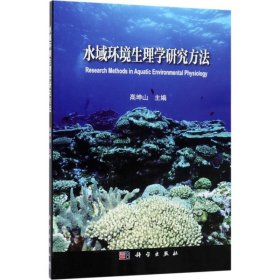
水域环境生理学研究方法
全新正版 极速发货
¥ 70.45 6.5折 ¥ 108 全新
仅1件
广东广州
认证卖家担保交易快速发货售后保障
作者高坤山 主编
出版社科学出版社
ISBN9787030574008
出版时间2018-06
装帧平装
开本16开
定价108元
货号1201722519
上书时间2024-09-06
- 最新上架
商品详情
- 品相描述:全新
- 商品描述
-
目录
章 化学与物理环境参数测定 1
节 海洋化学环境特征及海水碳酸盐体系参数测定与分析 1
第二节 可见光与紫外辐射测定 11
参考文献 14
第二章 培养系统调控与方法 15
节 碳酸盐体系调控 15
第二节 微藻连续与半连续培养 22
第三节 桡足类浮游动物的培养方法 27
参考文献 33
第三章 关键酶的测定 35
节 碳酸酐酶 35
第二节 固碳关键酶Rubisco 38
第三节 磷酸烯醇丙酮酸羧化酶 45
第四节 硝酸还原酶 48
第五节 抗氧化或活性氧自由基清除酶 50
参考文献 57
第四章 色素定量与分析 60
节 叶绿素 60
第二节 藻胆蛋白 66
第三节 类胡萝卜素 71
第四节 苯酚类物质 74
参考文献 76
第五章 叶绿素荧光技术与方法 80
节 调制叶绿素荧光等相关方法关键参数的解析 80
第二节 叶绿素荧光技术及其应用 93
第三节 电子传递过程与叶绿素荧光技术 100
第四节 碳转运能力与蓝绿荧光 110
第五节 原位浮游植物光化学参数测定 113
参考文献 117
第六章 光合与呼吸作用的测定与分析 124
节 光合放氧的测定 124
第二节 利用同位素(14C)示踪法测定光合固碳 130
第三节 光呼吸及光下暗呼吸的测定 134
第四节 藻类无机碳浓缩与亲和力的测定与解析 137
第五节 海水流通式藻类固碳的测定 143
第六节 浮游植物光系统Ⅱ光失活的测定 147
第七节 光系统损伤与修复的分析方法 151
第八节 光合固碳作用光谱 156
第九节 膜进样质谱仪在光合作用研究中的应用 160
参考文献 163
第七章 相关生化与分子生物学方法 169
节 常用生化抑制剂 169
第二节 颗粒有机碳、氮和磷测定 170
第三节 细胞器分离 173
第四节 钙化与硅化定量分析 176
第五节 转录组学、宏基因组学和宏转录组学在藻类研究中的应用 180
第六节 氮固定测定方法 183
第七节 海水痕量金属洁净培养技术 188
参考文献 196
第八章 动物与病毒的相关研究方法 202
节 鱼类神经电生理记录方法 202
第二节 贝类心率测定方法 206
第三节 植食性浮游动物摄食率测定方法 210
第四节 病毒与浮游植物关系的研究方法 216
参考文献 220
CONTENTS
Chapter 1 Measurements of chemical and physical environmental parameters 1
Section 1 Characteristics of marine chemical environment and measurements of seawater carbonate chemistry parameters 1
Section 2 Measurements of photosynthetically active radiation and ultraviolet radiation 11
References 14
Chapter 2 Plankton culture techniques 15
Section 1 Controlling stability of seawater carbonate chemistry 15
Section 2 Continuous and semi-continuous cultures of microalgae 22
Section 3 Culturing techniques of planktonic copepod 27
References 33
Chapter 3 Determination of key enzymes 35
Section 1 Carbonic anhydrase 35
Section 2 Rubisco 38
Section 3 Phosphoenolpyruvate carboxylase 45
Section 4 Nitrate reductase 48
Section 5 Antioxidants or reactive oxygen species (ROS) scavenging enzymes 50
References 57
Chapter 4 Analyses of pigments 60
Section 1 Chlorophyll 60
Section 2 Phycobiliprotein 66
Section 3 Carotenoids 71
Section 4 Phenolic compounds 74
References 76
Chapter 5 Chlorophyll fluorescence techniques and applications 80
Section 1 Basic concepts and key parameters of chlorophyll fluorescence 80
Section 2 The applications of chlorophyll fluorescence 93
Section 3 Photosynthetic electron transport and chlorophyll fluorescence techniques 100
Section 4 Inorganic carbon transport and blue-green fluorescences 110
Section 5 In situ measurements of phytoplankton photochemical parameters 113
References 117
Chapter 6 Measurements and analyses of photosynthesis and respiration 124
Section 1 Photosynthetic oxygen evolution 124
Section 2 Photosynthetic carbon fixation 130
Section 3 Photorespiration and mitochondrial respiration 134
Section 4 Determination of CO2 concentrating mechanisms and Cin affinity of algae 137
Section 5 Measurements of O2 evolution or consumption in flow-through seawater 143
Section 6 Measurement of photoinactivation of photosystemⅡ 147
Section 7 Determination of damage and repair rates of photosynthetic apparatus 151
Section 8 Action spectra of photosynthetic carbon fixation 156
Section 9 Application of membrane-inlet mass-spectrometer to photosynthesis research 160
References 163
Chapter 7 Physiology-related biochemical and molecular methods 169
Section 1 Biochemical inhibitors 169
Section 2 Measurements of particulate organic carbon, nitrogen and phosphorus 170
Section 3 Isolation of organelles 173
Section 4 Measurements of calcification and silicification 176
Section 5 The application of transcriptome, metagenome and metatranscriptome in algal research 180
Section 6 Methods for nitrogen fixation measurements 183
Section 7 Trace metal clean techniques for algal culturing 188
References 196
Chapter 8 Research methods for animal and virus 202
Section 1 Electrophysiological recording in fish 202
Section 2 Heart beat measurement in molluscs 206
Section 3 Measuring the grazing rate of herbivorous zooplankton 210
Section 4 Research methods of phytoplankton-virus interaction 216
References 220
内容摘要
为了应对环境变化生物学研究的需要,该书以海洋环境为主,介绍水环境生理学研究方法,聚焦海洋环境变化生理学的方法介绍,包括了室内、室外及航次方面的方法。从主要内容来看,包括藻类培养、化学环境的控制、光合、荧光技术、关键酶、色素、光生物学、分子与生理学接点的技术与方法等。
相关推荐
— 没有更多了 —






















以下为对购买帮助不大的评价